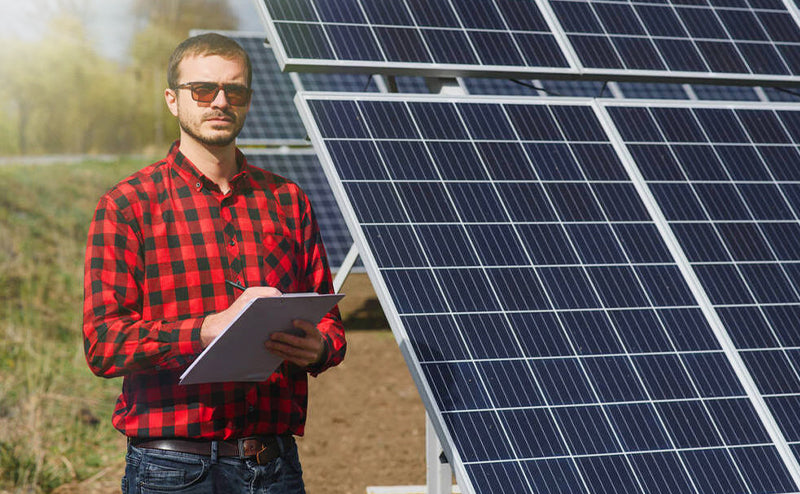In this unpredictable terrain of our world, switching to solar has almost become a necessity. But, while the decision to install solar panels may be easy, the process of choosing the right type of solar system for your needs can be a daunting task.
As an investor, you have to look at certain factors such as location, electricity cost, and frequency of power outages before making an informed decision about the solar system that is not only right for you but also lasts longer.
This guide will simplify the process by explaining the three types of solar systems, their pros and cons and the difference between them.
Three Types of Solar Systems
There are three ways your solar systems can work- by being connected to the grid, by being independent of the grid, or through a combination of both. Thus, there are three types of systems:
- On-Grid system
- Off-grid system
- Hybrid system
On-Grid System

Also known as the ‘grid-tied’, this type of solar system will generate energy only when it’s connected to the electrical grid.
The grid-tied inverter will receive Direct Current (DC) from the solar panels and convert it to Alternating Current (AC) to power the house appliances. But, it needs the grid to replicate the wave, frequency, and voltage of the current flowing into your house. This is why it only works when power from the electrical grid is available.
In case of a power outage or unavailability of grid power, the solar system will stop working entirely.
During the nighttime, or when solar panels are not generating enough power, the electrical grid can compensate for the demand. On the other hand, if excess energy is being generated through the solar panel and a net meter is available, it is sent back into the utility grid. The electrical company buys this power from you at a fixed rate, and the cost is deducted from your monthly electricity bill.
Primary Components: Solar Panel Array, Inverters, Meters, and Utility grid
Suitable for: Residential, commercial and industrial properties where grid power is readily available.
Pros:
- The system is easy to install and maintain
- More economical, as it does not require a battery backup system
- Surplus solar energy is not wasted but sold to the electrical company
- During cloudy days or low generation days, the grid can supply the power
Cons:
- Unable to store electricity
- Will not supply electricity during night time.
- Does not work during power outages as it is dependent on the power grid
Off-Grid System

The off-grid systems are fully independent of the grid as they are equipped with battery backup. The inverter charges the battery and runs the home appliances during the daytime. At night time or during power outages, the stored power can be used.
Off-Grid systems allow you to choose whether the solar panels charge the battery first or power the house. This type of solar installation can benefit remote or rural areas that experience frequent power cuts, but get sunlight all year round.
However, there are some disadvantages. When the panels aren’t as efficient due to cloud cover, rain or shade, etc. and the battery backup runs out, there is no power. For this reason, people generally install the off-grid system along their standard electricity connection to the grid.
Moreover, there are times when panels are extra efficient, and generate more than what is needed to charge a battery and run all appliances. In these cases, the surplus energy goes to waste.
Primary Components: Solar Panel Array, Inverters, and Batteries
Suitable for: Rural and remote areas, agricultural lands and industrial properties
Pros:
- Makes consumers fully self-reliant in energy production
- Allows electricity storage that can use during nighttime
- Protects against power outages and grid failures
Cons:
- More expensive than on-grid systems, due to the recurring cost of batteries
- Batteries have a small shelf life, are bulky, and are not very environmentally friendly
- Allows wastage of excess energy
- The system becomes unusable when power generation through panels is low
Hybrid Systems
Hybrid systems are relatively new to the solar market. It is a solar system that is connected to the utility grid and has an attached battery to store excess energy.
When the electrical power from the grid is available, the solar inverter will work as an on-grid inverter. When power fails, it will work like an off-grid inverter.
The chief benefit of the hybrid system is the availability of power in all situations. During the daytime, the panels will first power the home devices, while using the excess energy to charge the battery. In case there is a surplus, it is sent back to the utility grid.
The stored power can be used during the night when sunlight is not available. Moreover, when the generation is low and the battery is fully discharged, the power from the grid can work as a backup.
Primary Components: Solar Panel Array, Batteries, Inverters, Meter, and the Utility grid
Suitable for: Residential and commercial areas, agricultural lands, and industries
Pros:
- Equipped with load management technology
- Provides continuous power supply by storing electricity
- No loss of excess energy as surplus is sent back into the grid
Cons:
- High battery cost
- High cost of installation
- Longer break-even point
On-Grid vs Off-Grid vs Hybrid
|
Property |
On-Grid |
Off-Grid |
Hybrid |
|
Connection to Grid |
Yes |
No |
Yes |
|
Battery Backup |
No |
Yes |
Yes |
|
Night Time |
Uses Grid |
Uses battery |
Uses both grid and battery |
|
In case of low energy generation |
Supplements through electric grid |
Unable to charge battery |
Supplements through electric grid |
|
In case of surplus energy |
Sent back to Grid |
Wasted |
Sent Back to Grid |
|
Cost |
Low |
High |
High |
|
Works During Power Outages |
No |
Yes |
Yes |
|
Unit Adjustment in electricity bill |
Yes |
No |
Yes |
Best-In-Class Solar Panels, Inverters, and Accessories- All In One Place!
EXPLORE YOUR OPTIONS
How to Choose the Right System?
Before deciding on the type of solar system to go for, you must ask yourself the following questions.
- How accessible is electricity in your area?
- How frequent are power outages?
- What is the cost of residential/commercial electricity?
- How much are you willing to spend on solar installations?
If electricity is readily available and blackouts in your area are rare, an on-grid system would provide an economical solution for your energy needs. If power outages are common, go for an off-grid system that can store excess energy for later usage.
If the cost of electricity is high, a grid-tied system allows you to lower your electricity bills by selling the surplus power back into the grid.
Additionally, if your solar budget is substantial, go for hybrid solar systems that integrate the features of both, the on-grid and off-grid systems.
Now that you know about the advantages and disadvantages of on-grid, off-grid and hybrid systems, and are ready to install solar panels, go through the 7-point checklist to ensure that you are getting the highest value from your solar power system.
For more information, please click here: https://isolarparts.com
Twitter: Solarparts Instagram: Solarparts
Tumblr: Solarparts Pinterest: Solarparts
Facebook: Shenzhen Solarparts Inc
Email address: Philip@isolarparts.com



